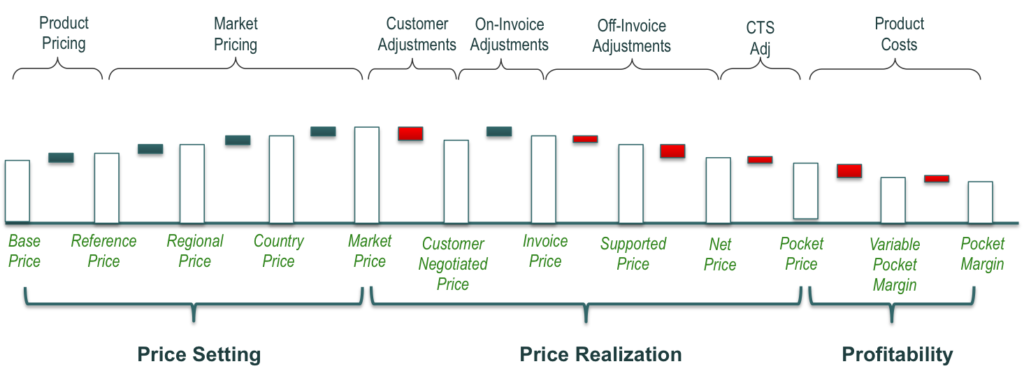
Waterfall pricing is a go-to strategy for many organizations, particularly as pricing pressure increases within the digital business era that has made markets more transparent and price comparisons easier. In such an environment, raising prices seems counter-intuitive – but this isn’t necessarily the case.
Simple but effective, the price waterfall (also known as the pocket price waterfall) is a useful framework for diagnosing margin leakage and, in today’s uncertain economic landscape, it’s more applicable than ever.
What is Waterfall Pricing?
The practice of deciding upon the most effective pricing for a product or service and the process by which an organization seeks to find the optimal price their customer is willing to pay is called price optimization.
In an effort to find the right price for the right product for the right customer, waterfall pricing illustrates how the price of a product or service decreases as the quantity sold increases. The price “falls down” as more is sold, thereby encouraging your customers to buy at higher quantities. Organizations use it to extend ‘customized’ pricing in a way that is easy to communicate.
Examples of Waterfall Pricing
You will find very basic examples of waterfall pricing across many industries. Retailers use it to encourage bulk purchases of their product. If one unit is priced at $100 for example, an agreement to purchase 10 units may come with a price tag of $80 each. Ticket sales are very often done the same way, as is software licensing and even freight shipping. The key is finding opportunities where discounts for larger quantities benefits both you and your customers. You can do this with a detailed analysis of your transactions.
Using a Price Waterfall to Drive Profits
When it comes to maximizing your profitability, raising pricing on a universal level may exceed your customers’ willingness to pay. In today’s economy, companies should instead look at making adjustments on a transaction-by-transaction basis to help recapture more of the charged price.
A price waterfall is an analysis tool that helps companies realize how much they are really pocketing after every transaction.
A series of influences can impact a product’s standard list price. Discounts, rebates, free delivery, and warranty are just some points on the extensive list of on- and off-invoice deductions that are often applied to purchases. After accounting for all of these value-added features, the pocket price can easily come to 20-30% less than the invoiced amount.
Even small price changes can result in substantial profit increases. A study of the Global 1200 found that increasing prices by 1% (providing demand remained constant) yielded an 11% increase in operating profits.
However, in the same way, a price decrease of 1% would lead to an 11% dip in profit. To be able to offer significantly lower prices, volumes would have to rise dramatically. As it stands, raising profits by lowering prices is by no means the best and most effective strategy.
Finding the 1% price increase isn’t a matter of changing prices across the board. Instead, it can be found by looking within existing operations and filling in the points of leakage mentioned above.
Using the pricing waterfall, it is possible to spot opportunities to fill in points of leakage. Looking along the waterfall will highlight the weakest and most expensive areas along the journey. By making adjustments, either to on-invoice discounts or to off-invoice costs, it is more than possible to improve the pricing of each transaction.
Although the price waterfall is regarded as an average of all transactions, the end pocket prices will vary from customer to customer depending on the discounts applied. The difference within this range is called the pocket price band.
The Best Way to Use Waterfall Pricing
A transaction pricing approach – that is, focusing on the exact price of each transaction and determining the level of discounts, incentives, allowances, etc., that should be applied – is therefore crucial for companies trying to put a stop to these shortfalls within their pricing strategy.
Since its inception, the price waterfall has come to play an important role in transaction pricing. As a visual representation of price transformation, it provides greater clarity for businesses trying to better understand how much they are, and how much they should be, charging each customer in each transaction.
Using waterfall pricing in this way is particularly useful for businesses who are looking to fix the problems caused by past errors in pricing strategies but are extracting little to no value from cost-cutting and other money-saving initiatives.

How to Create a Pricing Strategy that Follows the Waterfall Pricing Method
A basic waterfall pricing model will include the initial starting price (often the list price, but can also be the global or regional reference price) and move through the various transactions until it reaches the pocket margin. At each stage, it’s important to define which factors will influence the price points. A partial list of these factors may include:
- Cash discounts – deductions made for quick invoice payments
- Free delivery/returns – offering free delivery or returns leaves the business to shoulder the costs
- Off-invoice promotions – marketing incentives that offer rebates or discounts on sales
- Consignment costs – the cost of supplying consigned inventory
- Carrying costs – the cost of holding inventory in the period between sending an invoice and receiving payment
- Freight costs – the cost of transporting goods
- Marketing allowances – paying allowances to support advertising of the business by retail or wholesale brands
As competition grows, a natural response of many companies has been to attract new customers with more and more discounts. The biggest challenge comes when a handful or more of these additional features are offered, but the impact is not fully accounted for. This then results in a pricing strategy that doesn’t align with the real costs and can significantly eat into margins.
Take, for example, a computer company who sells laptops to distributors. Every laptop sold has a base, or list, price. However, after a series of discounts (standard distributor discounts plus large volume discounts and discounts from promotions) have been applied to the order, the invoice shows the price as 30% less than originally stated.
It’s fairly common to see companies stop measuring prices at the invoice level. However, this results in the series of additional discounts being overlooked. On top of the 30% on-invoice discounts, the computer company also experiences a number of off-invoice leaks including cash discounts, free delivery and carrying costs – culminating in another 15% off the price. Once totalled, the pocket price is nearly half off the original list price.
Challenges of Price Waterfalls
Having a wide pocket price band may seem like an unwelcome surprise to some, but it isn’t necessarily a bad thing. A narrower band means less maneuverability with small changes at one end having a significant impact at the other. In contrast, wider bands indicate more pricing opportunities to be captured.
That being said, looking closer at each end can reveal which customers are benefitting the most from the pocket price waterfall. It may reveal if it is indeed the larger volume, higher-value orders receiving the better discounts, or if it is the smaller distributors benefitting the most.
If the latter, this might be a sign that better transaction pricing controls are needed. It also presents an opportunity to implement longer-term fixes by investing in technology that affords much better visibility over discounts and ultimate pocket prices while providing a more effective guide for price negotiations.
The sheer number of transactions going through in a day can pose a challenge, however. To make sure the price waterfall accurately and coherently represents the needs of a business, it’s necessary to establish the right level of visibility. Tracking transactions is useful, but only possible with access to customer and transaction-specific data.
Read the Case Study
How global pricing at an energy giant transformed into a well-oiled machine
Summary & Key Takeaways
Pricing, particularly transaction pricing, is still an oftentimes untapped source of revenue, especially in volatile times. A fruitful transaction pricing strategy boils down to a number of day-to-day decisions that influence ultimate price points. This is why the price waterfall is so powerful. It’s an important profitability tool.
- Waterfall pricing illustrates how the price of a product or service decreases as the quantity sold increases. It helps organizations offer ‘customized’ pricing.
- A price waterfall is a tool that helps companies realize how much they are really pocketing after every transaction.
- Even small price changes can result in substantial profit increases. Increasing prices by 1% yields an 11% increase in operating profits. At the same time, a price decrease of 1% would lead to an 11% dip in profit. To offer significantly lower prices, volumes would have to rise dramatically.
- A pricing waterfall helps spot opportunities to fill in points of leakage found in areas like discounts, rebates, and warranties. By making adjustments, it is more than possible to improve the pricing of each transaction.
- Too often, companies fail to track losses on a transaction-by-transaction basis, resulting in valuable percentage points being shaved off the pocket price. By spotting these leaks with a price waterfall, it’s possible to regain revenue one transaction at a time and grow profitability.
